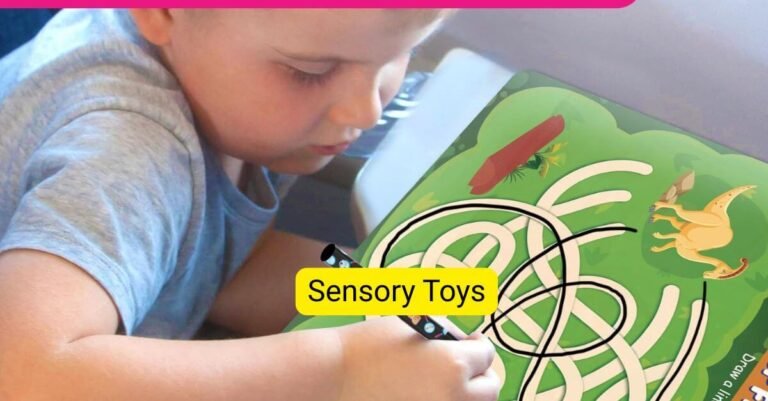Sensory Toys – Children learn about the world through their senses. They see, hear, touch, taste, and smell to understand what is around them. Sensory toys help children use these senses. They make learning fun and easy. In this article, we will talk about sensory toys and how they help children grow.
What Are Sensory Toys?
Sensory toys are toys designed to touch different senses. These toys may have different shapes, colors, sounds, or textures. They help children explore and learn about their feelings and the environment.
For example, some sensory toys make sounds. Others have soft or rough surfaces to touch. Some toys even light up or change colors. These features help children focus on one or more senses.
Why Are Sensory Toys Important?
Sensory toys help children in many ways. Here are some reasons why they are important:
- Improve focus: Sensory toys can help children pay attention.
- Calm the mind: Some toys help children feel calm and relaxed.
- Develop skills: Toys help improve motor skills and hand-eye coordination.
- Encourage creativity: Children use their imagination while playing.
- Support learning: They help children learn about shapes, colors, and sounds.
Types of Sensory Toys
There are many types of sensory toys. Each toy targets different senses. Let’s look at some common types:
1. Touch Toys
Touch toys help children feel different textures. These toys may be soft, rough, bumpy, or smooth. Children learn about how things feel by touching these toys.
Examples include:
- Soft stuffed animals
- Squishy balls
- Textured mats or blocks
2. Sound Toys
Sound toys make noises that children can hear. These toys help children understand different sounds and rhythms.
Examples include:
- Musical instruments like drums or maracas
- Toys that play music or animal sounds
- Rattles
3. Sight Toys
Sight toys are colorful and bright. They catch children’s attention and help them learn about colors and shapes.
Examples include:
- Light-up toys
- Colorful blocks
- Toys with moving parts or patterns
4. Smell Toys
Some sensory toys have scents. These toys help children explore smells.
Examples include:
- Scented play dough
- Scratch and sniff cards
5. Taste Toys
Taste toys are less common but still useful. They help children learn about taste safely.
Examples include:
- Edible sensory play materials (like flavored gelatin)
- Safe chewable toys for babies
Benefits of Sensory Toys for Children
Sensory toys offer many benefits. They help children in their growth and learning. Here are some key benefits:
| Benefit | Explanation |
|---|---|
| Better Focus | Sensory toys can help children concentrate better on tasks. |
| Improved Motor Skills | Playing with toys helps with hand and finger movements. |
| Emotional Calm | Some toys help children feel relaxed when upset. |
| Learning New Things | Toys teach children about colors, shapes, sounds, and textures. |
| Better Social Skills | Playing with others improves sharing and teamwork skills. |
How to Choose Sensory Toys
Choosing the right sensory toy is important. Here are some tips to help you pick the best toys for children:
- Think about the child’s age. Toys should be safe and fit their size.
- Choose toys that match the child’s interests. For example, if a child likes music, try sound toys.
- Pick toys that help different senses. A mix of touch, sight, and sound toys is good.
- Look for toys that are safe and easy to clean.
- Start with simple toys and move to more complex ones as the child grows.
How to Use Sensory Toys
Using sensory toys is easy. Here are some ideas:
- Let the child explore the toy on their own.
- Play together. Show the child how to use the toy.
- Ask questions. For example, “How does it feel?” or “What sound do you hear?”
- Use toys to calm the child when they feel upset.
- Include sensory toys during playtime and learning time.
Credit: www.mindware.orientaltrading.com
Credit: www.ebay.com
Sensory Toys for Children with Special Needs
Sensory toys are very helpful for children with special needs. Some children have trouble with senses. Sensory toys can support their learning and calm their emotions.
Many therapists use sensory toys in their work. They help children with autism, ADHD, and other challenges. These toys help children focus, calm down, and learn new skills.
Examples of Popular Sensory Toys
Here are some popular sensory toys that many children enjoy:
- Fidget spinners: Small toys that spin in the hand.
- Play dough: Soft and squishy material to shape and mold.
- Bubble wrap: Popping bubbles is fun and good for touch.
- Water beads: Small, colorful beads that feel smooth and squishy.
- Sensory balls: Balls with different textures and sizes.
Making Your Own Sensory Toys
You can make sensory toys at home. This is a fun and cheap way to help children.
Here are some easy ideas:
- Fill a bottle with water and glitter. Shake it to see the sparkling.
- Use rice or beans in a box. Let children feel and move them.
- Make a simple puzzle with cardboard and colors.
- Create a texture board with different fabrics.
Making toys together can be a fun activity for parents and children.
Frequently Asked Questions
What Are Sensory Toys And Why Do Kids Need Them?
Sensory toys help kids explore touch, sound, and sight. They improve learning and focus.
How Do Sensory Toys Support Child Development?
They boost motor skills, hand-eye coordination, and sensory processing.
Can Sensory Toys Help Children With Autism?
Yes, these toys calm and improve attention for many autistic children.
What Materials Are Common In Sensory Toys?
Soft fabrics, rubber, beads, and lights are often used for different senses.
Conclusion
Sensory toys help children learn about the world. They touch many senses like sight, sound, and touch. These toys improve skills, calm emotions, and encourage creativity.
Choosing the right sensory toys depends on the child’s needs and interests. Using sensory toys every day helps children grow healthy and happy.
Remember, play is a child’s way to learn. Sensory toys make play even better.


